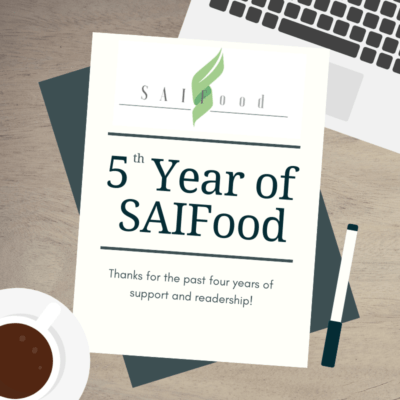Changes observed as SAIFood turns 5
How often do we say to ourselves or to friends, ‘I’m bored, nothing ever happens’? Well, I discovered a cure for this! Writing, editing and publishing 40+ blogs a year certainly keeps me busy and raises my awareness about what is happening. It has also made me a better writer, as my first blog took 3 days to write! So, as SAIFood enters into its 5th year of sharing and communicating about sustainable agriculture, innovation and food, here’s the top 5 things I’ve noticed.
1. The speed of advances in plant breeding technology.
Four years ago, few knew about genome editing and considerably less about CRISPR/cas9. In this short span, the technology has erupted across the world, creating innovation potentials such as nutritionally enhanced crops (tomato), 40% higher yielding crops (rice), less pathogenic poultry and faster-growing fish. Genome editing could revolutionize not only how food is produced, but our relationship with food, allowing us to eat healthier foods. At the rate genome editing is advancing, it’s entirely feasible to see the day when foods contain enhance proteins that are designed to fight multiple diseases, possibly even cancer.
2. The increase in agvocacy.
I’ve seen a dramatic rise in the number of farm organizations, commodity groups, Ag firms, farmers and Ag students involved in communicating the stories of our industry. Consumer trust surveys show that farmers possess a high level of trust to speak about food production and the environment. While it isn’t a tsunami, I’ve seen the farm community begin to venture onto social media and share why they farm the way they do. By doing so, they’re not only being transparent with consumers, but they’re also writing their own stories rather than letting others do so.
3. Regulatory support for science-based regulations.
Regulatory agencies across North and South America; Australia and New Zealand; Japan, Korea and other Asian nations; and in African nations as well, have demonstrated their support for science-based regulations. The vast, vast majority of regulatory agencies have been very publicly supportive of science-based regulation. One only has to examine the list of regulatory agencies around the world that have rejected the IARC classification of glyphosate as probably carcinogenic for proof of their support.
4. The quantification of GM crop benefits.
While the scientific advancements have been rapid, social sciences have been trotting along at a pretty decent clip as the list of quantified benefits from GM crops is impressive. Possibly the most significant was the research quantifying the reduction in cancer causing toxins from GM corn. The study found that GM corn has lower concentrations of mycotoxins (−28.8%), fumonisin (−30.6%) and tricotecens (−36.5%). The other bit of scientific evidence that caught my eye was the size of the farm level cost, should glyphosate be banned globally. A farm income loss of $6.76 billion has been estimated.
5. On a more personal note, the vitriol of eNGO attacks on the Ag industry.
The dramatic rise in the number of nameless and faceless accounts on social media, especially Twitter, has dramatically increased. Troll accounts are simply there to spew vile, hateful and factless accusations against those that communicate benefits from GM crops or the safe use of chemicals in crop production. As their actions become more and more hateful, it provides me with great confidence that this is their last ditch attempt as consumers are beginning to tune out their constant message of dire warnings. Who would have thought that constantly yelling ‘wolf’ for 20 years would backfire?
Thank you to our readers, it has been a wonderful four years. I look forward to a busy fifth year, and the stories we will learn about together over the course of this coming year.


